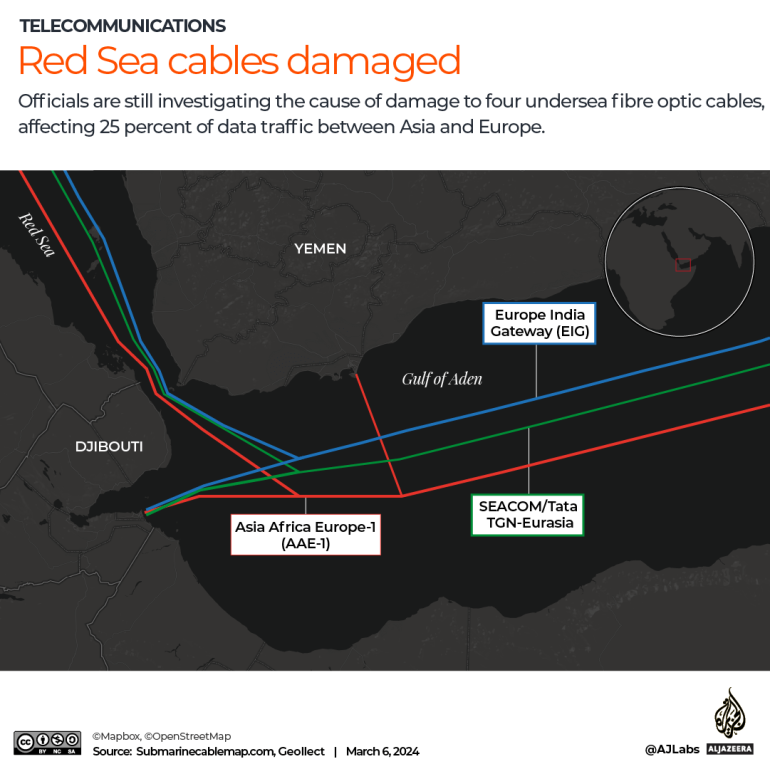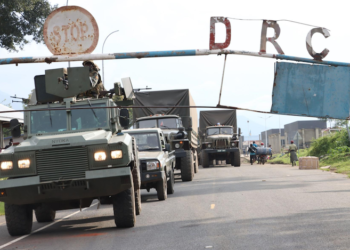By AL JAZEERA
Beirut, Lebanon – Officials in the United States say undersea telecommunications cables in the Red Sea were cut on Tuesday, disrupting 25 percent of data traffic between Asia and Europe.
A US official told the BBC they were attempting to find out if the cables had been sabotaged or if it was the result of an anchor dragging along the seafloor.
But what are these cables? Who put them there? How important are they?
Here’s everything you need to know about the world of undersea cables.

What are undersea cables for?
Communication.
Telecommunication signals and messages cross stretches of the ocean through these cables at nearly the speed of light.
Sixteen fibre optic cables, accounting for 17 percent of all international internet data traffic, run along the seabed of the Red Sea.
Who owns them?
Nearly all of the world’s undersea cables are owned by private companies – telecom operators or investors.
Only about 1 percent are owned (in part or whole) by a government.
What happens if undersea cables are cut?
In short, global communication is disrupted.
“Subsea infrastructure is now … such a critical component of the global economy that … it can have a disproportionately high impact,” Nick Loxton, head of intelligence delivery at Geollect, told Al Jazeera.
Remember how the Red Sea has 17 percent of all international internet data traffic? If all the cables there are taken out, it would disrupt Europe’s communication with India and East Asia and hit North and East Africa.
Which cables were cut on Tuesday and how?
Four out of nearly 20 submarine cables in the Red Sea – Seacom, TGN-Gulf, Asia-Africa-Europe 1 and Europe India Gateway – were cut on Tuesday, according to HGC Global Communications, which operates on the cables.
Officials are still trying to figure out how they were cut. Theories include that it could have been an anchor catching the cables or a deliberate disruption.
What effect did that have?
In the past, damaged cables have led to interruptions in internet service, but “most … companies that rely on these cables have alternative routes”, according to Loxton.
HGC Global said the crucial traffic that goes through the Red Sea was rerouted.

Is there a Houthi connection to the cables being cut?
The Houthis have issued a statement denying responsibility for cutting the cables.
In February, the Houthis published a map on their Telegram channel that showed the cables running along the bottom of the Red Sea.
Telecom firms linked to Yemen’s internationally recognised government, who oppose the Houthis, said they fear the rebels may target undersea cables.
“It’s increasingly seen as a valid target for actors involved in violent conflict,” Loxton commented on the idea. “It is a high-value target which they can target for relatively low cost.”
Why did some people think the Houthis did it?
The Houthis have been attacking Israel-linked vessels in the Red Sea in declared support for the people of Palestine.
They recently struck a Belize-flagged, UK-owned bulk carrier, the Rubymar, with two missiles. The vessel has sunk and has been leaking oil since the attack and now there are fears for the 41,000 tonnes of volatile fertiliser it carried.
Commercial ships sometimes lose their anchors, which then cut cables. Loxton noted that, in 2023, a Russian fibre optic cable was severed under the Baltic Sea when a Chinese container ship dragged its anchor over the seabed.
Some experts believe the Houthis would need help from an ally to damage the cables, while others have said they could be capable of causing damage on their own.
“I think, with the proliferation of technology, basically democratising things like drones … operations that previously seemed impossible for a relatively non-sophisticated, non-state actor like the Houthis are now perfectly within their reach,” Loxton said.
Where are the world’s undersea cables?
Everywhere.
Today, there are about 380 cables in operation, with a total length of more than 1.2 million km (745,645 miles). That is enough to reach the moon and back with plenty left over.
The cables are often in bundles along the seafloor, meaning that damage is often sustained by more than one cable.
The Red Sea has a series of cables running through its relatively shallow water.







Discussion about this post